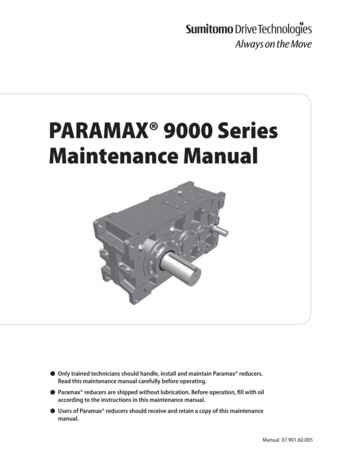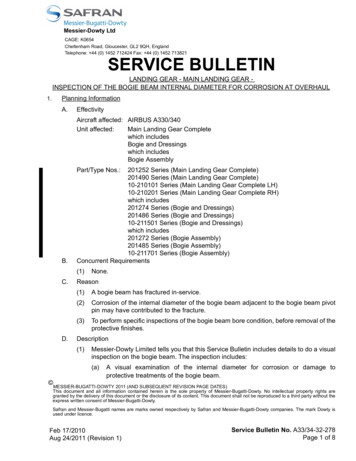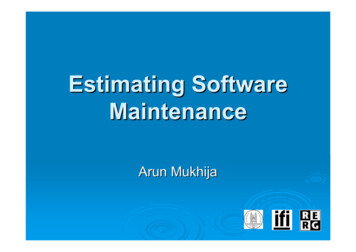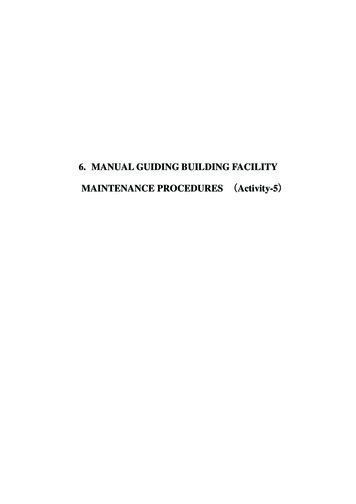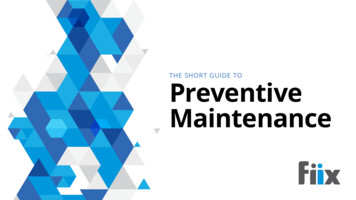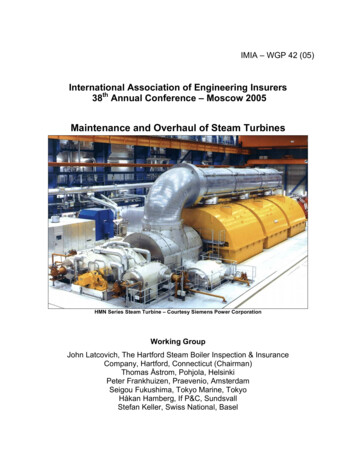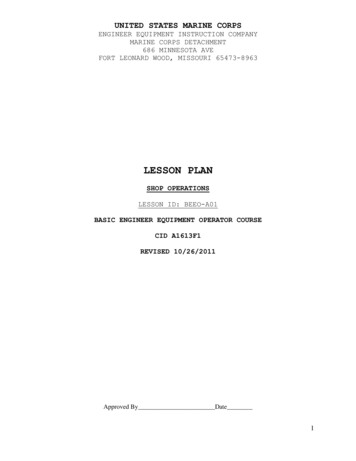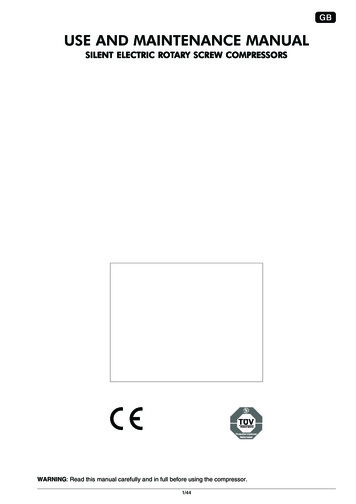
Transcription
GBUSE AND MAINTENANCE MANUALSILENT ELECTRIC ROTARY SCREW COMPRESSORSROTARYPRODUCT SERVICEProduction monitoredSafety testedWARNING: Read this manual carefully and in full before using the compressor.1/44
IMPORTANT INFORMATIONRead all the operational instructions, safety recommendations and all warnings provided in the instruction manual.Most accidents encountered when using the compressor are merely due to the failed observance of basic safetystandards.Accidents are prevented by foreseeing potentially hazardous situations and observing the appropriate safetystandards.The fundamental safety standards are listed in the “SAFETY” section of this manual and also in the section involvingthe use and maintenance of the compressor.Hazardous situations to be avoided in order to prevent serious personal injuries and machine damages are listedin the “WARNINGS” section of the instruction manual or are actually printed on the machine.Never use the compressor improperly but only as recommended by the Manufacturer.The Manufacturer reserves the right to up-date the technical information given in this manual without notice.2/44
FOREWORD0GBIIndex0Foreword. 510.1How to read and use the instruction manual . 50.1.a0.1.b0.1.c0.1.dImportance of the manual .Conserving the manual .Consulting the manual .Symbols used .General information . 71.11.21.325General description . 10Intended use . 10Technical data . 11Transport, Handling, Storage. 123.13.23.34Identification data of the manufacturer and the compressor . 7Information on machine technical/maintenance service . 7General safety warnings . 7Preliminary machine information . 102.12.22.335556Transporting and handling the packed machine. 12Packing and unpacking . 12Storing the packed and unpacked compressor . 13Installation . 144.14.24.34.4Admitted surrounding conditions . 14Space required for maintenance . 14Positioning the compressor . 15Connecting the compressor to the sources of energy and relative inspections 164.4.14.4.2Connecting the compressor to the electrical mains power supply . 16Connecting to the pneumatic mains (compressor a on the ground) . 19Using the compressor . 205.1Preparing to use the compressor . 205.1.15.1.2Operational principle . 20Tank . 205.2Controls, indicators and safety devices of the compressor . 215.2.15.2.25.2.3Control panel . 21Display . 22Auxiliary control devices . 255.3Check the efficiency of the safety devices before starting . 253/44
GBIINDEX5.45.567Starting the compressor. 25Stopping the compressor . 26Compressor maintenance. 276.1Instructions relative to inspections and maintenance jobs. . .10Changing the oil .Replacing the oil filter cartridge.Replacing the filter cartridge of the oil separator .Replacing the air filter cartridge .Tightening the belt .Replacing the belt .Cleaning the air/oli radiator .Cleaning the dust-removal pre-filter .Lubricating the electric motor .Draining the condensate .6.2Diagnosing the alarm status/inconveniences-faults . 3430313132323233333334Drawings and diagrams . 377.17.2Wiring diagrams . 37Pneumatic diagrams . 404/44
FOREWORD0GBMaintenance schedule0Foreword0.1How to read and use the instruction manual0.1.aImportance of the manualThis INSTRUCTION MANUAL has been written to guide you through the INSTALLATION, USE andMAINTENANCE of the compressor purchased.We recommend that you strictly observe all the indications given within as the ideal operational efficiencyand lasting wear of the compressor depend on the correct use and methodical application of themaintenance instructions given hereafter.Remember that when any doubts or inconveniences arise it is a good rule to always contact theAUTHORISED SERVICE CENTRES. They are at your complete disposal for any explanations or jobsrequired.The Manufacturer therefore declines all liabilities regarding the incorrect use and poor maintenance of thecompressor.The INSTRUCTION MANUAL is integral part of the compressor.Ensure that any up-dates forwarded by the Manufacturer are actually added to the manual.If the compressor is sold on at a later date the manual must be given to the new owner.0.1.bConserving the manualUse and read the manual with care being careful not to damage any part of it.Do not remove, tear or re-write any parts of the manual for any reason whatsoever.Keep the manual in a dry and sheltered place.0.1.cConsulting the manualThis instruction manual is made up of the following: FRONT COVER WITH MACHINE IDENTIFICATIONDETAILED INDEXINSTRUCTIONS AND/OR NOTES ON THE COMPRESSORThe model and serial number of the compressor to which the manual refers and that you have purchasedis found on the FRONT COVER.The various SECTIONS in which all the notes relative to a certain subject are found in the INDEX.All the INSTRUCTIONS AND/OR NOTES ON THE COMPRESSOR aim at pointing out safety warningsand procedures required to use the compressor correctly.5/44
GB0.1.d0FOREWORDSymbols usedThe SYMBOLS pointed out below are used throughout this manual and their purpose is that of drawing theoperator’s attention, informing the latter how to behave and how to proceed in each operational situation.READ THE INSTRUCTION MANUALRead the use and maintenance manual carefully before installing and starting thecompressor.GENERAL HAZARDOUS SITUATIONAn additional note will point out the type of hazard involved.Meaning of the indications:Warning!This points out a potentially hazardous situation, which if ignored, could cause personalinjury and machine damage.Note!This enhances crucial information.RISK OF ELECTRIC SHOCKWarning: the electrical power supply of the compressor must be disconnected beforedoing any jobs on the compressor.RISK OF SCOLDINGWarning: be careful when touching the compressor as some parts of it could be very hot.6/44
GENERAL INFORMATION1General information1.1Identification data of the manufacturer and the compressor1GBCOMPRESSORIDENTIFICATIONNAMEPLATE (Example)Silent electric rotary screw compressor.1.2Information on machine technical/maintenance serviceWe remind you that our technical service department is at your complete disposal to help you resolve anyproblems that may possibly be encountered, or to provide you with any other information necessary.In the case of need contact:Our CUSTOMER TECHNICAL SERVICE department or your local dealer.The constant and efficient performance of the compressor is ensured only if original spare parts are used.We recommend therefore that you strictly observe the indications provided in the MAINTENANCE sectionand to use EXCLUSIVELY original spare parts.The use of NON ORIGINAL spare parts automatically annuls the guarantee.1.3General safety warningsNote!The procedures provided in this manual have been written to assist the operatorthroughout the use and maintenance of the compressor.IMPORTANT INSTRUCTIONS FOR THE SAFE USE OF THE COMPRESSORWARNING: THE INAPPROPRIATE USE AND POOR MAINTENANCE OF THIS COMPRESSOR MAYCAUSE PHYSICAL INJURY TO THE USER. YOU ARE RECOMMENDED TO CAREFULLY FOLLOWTHE INSTRUCTIONS PROVIDED HEREAFTER TO AVOID SUCH RISKS.7/44
GB1GENERAL INFORMATION1. DO NOT TOUCH MOVING PARTSNever put your hands, fingers or other parts of the body near moving parts of the compressor.2. NEVER USE THE COMPRESSOR WITHOUT THE SAFETY GUARDS FITTEDNever use the compressor without all the safety guards fitted perfectly in their correct place (i.e. panelling,belt guard, safety valve). If these parts are to be removed for maintenance or servicing purposes, ensurethat they are put back in their original place perfectly before using the compressor again.3. ALWAYS WEAR SAFETY GOGGLESAlways wear goggles or equivalent eye protection means. Never direct compressed air towards any partof your body or that of others.4. PROTECT YOURSELF AGAINST ELECTRIC SHOCKSAvoid accidentally touching the metal parts of the compressor with your body, such as pipes, the tank ormetal parts connected to earth. Never use the compressor where there is water or in damp rooms.5. DISCONNECT THE COMPRESSORDisconnect the compressor from the electric power supply and completely discharge the pressure from thetank before carrying out any service, inspection, maintenance, cleaning, replacing or inspection jobs ofeach part.6. ACCIDENTAL START-UPNever move the compressor while it is connected to the electrical power supply or when the tank ispressurised. Ensure that the main switch is turned OFF before connecting the compressor to the electricalpower supply.7. STORE THE COMPRESSOR APPROPRIATELYWhen the compressor is not in use, it must be stored in a dry room away from atmospheric agents. Keepit out of children’s reach.8. OPERATIONAL AREAKeep the work area clean and remove any tools that are not required. Keep the work area sufficientlyventilated. Never use the compressor in the presence of flammable liquids or gas. The compressor mayproduce sparks while running. Do not use the compressor where there may be paints, gasoline, chemicalcompounds, glues and any other flammable or explosive material.9. KEEP THE COMPRESSOR OUT OF CHILDREN’S REACHPrevent children or anyone else from touching the power supply cable of the compressor. All outsiders mustbe kept at a safe distance from the operational area.10.WORK CLOTHESDo not wear unsuitable clothing, ties or jewellery as these may get caught up in moving parts. Wear capsto cover your hair if necessary.11.PRECAUTIONS FOR THE POWER SUPPLY CABLEDo not disconnect the power supply plug by pulling on the cable. Keep the cable away from heat, oil andsharp edges. Do not stand on the electrical cable or squash it under heavy weights.12.LOOK AFTER THE COMPRESSOR WITH CAREFollow the maintenance instructions. Inspect the power supply cable on a periodic basis and if damaged it mustbe repaired or replaced by an authorised service centre. Visually check the outside appearance of thecompressor, ensuring that there are no visual anomalies. Contact your nearest service centre if necessary.13.ELECTRICAL EXTENSIONS FOR OUTDOOR USEWhen the compressor is used outdoors, use only electrical extensions manufactured for outdoor use andmarked as such.14.WARNINGPay attention to everything you do. Use your common sense.Do not use the compressor if you are tired. The compressor must never be used if you are under the effectof alcohol, drugs or medicines, which could make you tired.15.CHECK FAULTY PARTS OR AIR LEAKSBefore using the compressor again, if a safety guard or other parts are damaged, they must be checked carefullyto evaluate whether they may operate as established in complete safety. Check the alignment of moving parts,hoses, gauges, pressure reducers, pneumatic connections and every other part that may be crucial for the normaloperational efficiency of the compressor. All damaged parts must be properly repaired or replaced by anauthorised service centre or replaced following the instructions provided in instruction manual.16.USE THE COMPRESSOR EXCLUSIVELY FOR THE APPLICATIONS SPECIFIED IN THISINSTRUCTION MANUAL.The compressor is a machine that produces compressed air.Never use the compressor for purposes other than those specified in the instruction manual.17.USE THE COMPRESSOR CORRECTLYOperate the compressor in compliance with the instructions provided in this manual. Do not allow childrento use the compressor or those who are not familiar with it.8/44
GENERAL INFORMATION1GB18.ENSURE THAT EACH SCREW, BOLT AND GUARD IS FIRMLY SECURED IN PLACE.19.KEEP THE IN-TAKE GRIDS CLEANKeep the motor ventilation grids clean. Regularly clean these grids if the work area is particularly dirty.20.OPERATE THE COMPRESSOR AT THE RATED VOLTAGEOperate the compressor at the voltage specified on the electric data plate. You could damage or burn-outthe motor and other electric components if the compressor is operated at a higher or lower voltage than itsrated voltage.21.NEVER USE THE COMPRESSOR IF IT IS FAULTYIf the compressor is noisy or vibrates excessively when running or it seems to be faulty, stop it immediatelyand check its efficiency or contact your nearest authorised service centre.22.DO NOT CLEAN PLASTIC PARTS USING SOLVENTSSolvents such as gasoline, thinners, gas oil or other compounds that contain hydrocarbons may damagethe plastic parts. Clean them with a soft cloth and soapy water or other suitable liquids.23.USE ORGINAL SPARE PARTS ONLYThe use of non-original spare parts involves the annulment of the guarantee and the abnormal runningconditions of the compressor. Original spare parts are available c/o the authorised dealers.24.DO NOT MODIFY THE COMPRESSORDo not modify the compressor. Contact an authorised service centre for all repairs required. Anunauthorised modification may impair the efficiency of the compressor and may also cause seriousaccidents for those who do not have the technical skill required to make such modifications.25.TURN THE COMPRESSOR OFF WHEN IT IS NOT IN USEWhen the compressor is not in use turn the main ON/OFF switch OFF (position “0”).26.DO NOT TOUCH HOT PARTS OF THE COMPRESSORTo avoid scolding do not touch pipes, the motor or any other hot part.27.DO NOT DIRECT THE JET OF AIR DIRECTLY TOWARDS THE BODYTo avoid all risks never direct the jet of air towards people or animals.28.DO NOT STOP THE COMPRESSOR BY PULLING ON THE POWER SUPPLY CABLEUse the “O/I” (ON/OFF) buttons of the control panel to stop the compressor.29.PNEUMATIC CIRCUITUse recommended pneumatic hoses and tools that can withstand the same or a higher pressure than themaximum running pressure of the compressor.30.SPARE PARTSUse only original and identical spare parts to replace worn or damaged ones.Repairs must be made exclusively by authorised service centres.31.CORRECT USE OF THE COMPRESSORThe operator must be perfectly familiar with all the controls and compressor characteristics before startingto work with the machine.32.MAINTENANCE JOBSThe use and maintenance jobs of the commercial components fitted on the machine, but not indicated inthis manual, are indicated in the enclosed documents.33.DO NOT UNSCREW THE CONNECTION WHEN THE TANK IS PRESSURISEDDo not unscrew the connection for any reason whatsoever with the tank pressurised without first checkingif the tank is discharged.34.DO NOT MODIFY THE TANKIt is prohibited to intentionally drill, weld or deform the compressed air tank.35.IF THE COMPRESSOR IS USED FOR PAINTING JOBSa) Do not work in closed rooms or near free flames.b) Ensure that the room in which you are working is sufficiently ventilated.c) Wear face and nose mask.36.DO NOT PUT OBJECTS OR PARTS OF THE BODY IN THE PROTECTION GRIDSDo not put objects or parts of the body in the protection grids to prevent physical injuries and damage to thecompressor.KEEP THESE USE AND MAINTENANCE INSTRUCTIONS CAREFULLY AND GIVETHEM TO PERSONNEL WISHING TO USE THE COMPRESSOR!WE RESERVE THE RIGHT TO MAKE MODIFICATIONS WHERE NECESSARYWITHOUT NOTICE9/44
GB2PRELIMINARY MACHINE INFORMATION2Preliminary machine information2.1General descriptionThe rotary screw compressor has been specifically designed aiming at minimising maintenance andlabour costs.The outside cabinet is completely covered in sound-proof and oil-proof panelling thus ensuring its extendedand lasting wear.The components have been arranged so that all vital parts can be easily reached for maintenance purposessimply by opening dedicated panels with quick-release locking devices.The filters and adjustment and safety devices (oil filter, air filter, oil separator filter, regulator valve, minimumpressure valve, max. pressure safety valve, thermostat, belt tightener, screw compression unit, pressureswitch and oil separator tank emptying and filling taps) are all fitted on the same side.The dryer series has been devised with the intention of enclosing a complete compressed air system inone compact machine. It is indeed connected to a dryer that is capable of supplying dry air to ensure theperfect and lasting use of the tools.Note!The tanks of the compressors have been manufactured in compliance with the EEC/404/87 Directive for the European market.The compressors have been manufactured in compliance with the EC/37/98 Directivefor the European market.Note!Check your model on the identification nameplate fitted on the compressor. It is alsoindicated in this manual.ADVISED LUBRICANTSAlways use oil for turbines with approximately 46 cSt at 40 C and a pour point of at least -8 10 C. Theflash point must be greater than 200 C.NEVER MIX DIFFERENT OIL QUALITIES.SCREW OILESSOBPSHELLTOTALMOBILDUCKHAMSEXXCOLUB 46ENERGOL HLP 46CORENA D 46AZOLLA ZS 46DTE OIL 25ZIRCON 46Use oil with VG32 rating for cold climates and VG68 for tropical climates.It is advisable to use synthetic oils for very hot and humid climates.2.2Intended useThe silent rotary screw compressors have been designed and manufactured exclusively to produce compressed air.EVERY OTHER USE, DIFFERENT AND NOT FORESEEN BY ALL INDICATED, RELIEVES THEMANUFACTURER OF POSSIBLE CONSEQUENT RISKS.In any event the use of the compressor different to that agreed in the purchase order RELIEVES THEMANUFACTURER FROM ALL LIABILITIES WITH REGARD TO POSSIBLE MATERIAL DAMAGE ANDPERSONAL INJURY.The electrical system is not designed for the use in environments subject to explosion or for flammable products.NEVER DIRECT THE JET OF AIR TOWARDS PEOPLE OR ANIMALS. NEVER USETHE COMPRESSED AIR PRODUCED BY LUBRICATED COMPRESSORS FORRESPIRATORY PURPOSES OR IN PRODUCTION PROCESSES WHERE THE AIR ISIN DIRECT CONTACT WITH FOODSTUFFS UNLESS IT HAS BEEN FIRST FILTERED10/44
IEC2-pole electric motor11/4410N C (min/max)dB(A)Max. starts per hourAmbient temperature limitsNoise level695/4510S15525/18,5MEC160 36,51” G96695/4510S15525/18,5MEC160 36,51” G79224013-188Note! The technical data and dimensions of the machine are subject to variations at any time without notice705/4510S15530/22MEC160 36,51” G12535408-116Sound level measured in a free range at a distance of 4 m: 3 dB(A) at the maximum working pressure.695/45S15525/18,5MEC160 36,51” GServiceIPppmOil residue in airProtection ratingm3/hFan capacityHP/kWlLubricant qtyOutputRAir outlet fitting108cfm27103050Free air delivery ISO 1217l/minNK100Type of rotary screw end10-1458-116Max. pressurebar/psiHP25Technical dataModel2.3705/4510S15530/22MEC160 36,51” G1133190NK10010-145HP30705/4510S15530/22MEC160 36,51” G96272013-188725/4510S15540/30MEC180 36,51” G140,439808-116725/4510S15540/30MEC180 36,51” G131,33720NK10010-145HP40725/4510S15540/30MEC180 36,51” G113320013-188PRELIMINARY MACHINE INFORMATION2GB
GB3TRANSPORT, HANDLING, STORAGEAND CONDITIONED FOR SUCH PURPOSE.3Transport, Handling, StorageIn order to use the compressor in complete safety read the safety standards givenin section 1.3. before reading this section.3.1Transporting and handling the packed machineThe packed compressor must be transported by qualified personnel using a forklifttruck.Before moving the machine ensure that the load-bearing capacity of the forklift truck is sufficient to takethe weight to be lifted.Position the forks exclusively as illustrated below. Once the forks have been positioned in the pointsindicated, lift slowly without jerking.Never stand near the area where the compressor is being handled and never standon the crate while it is being moved.3.2Packing and unpackingTo avoid damages and to protect the compressor during transport it is usually placed on a wooden pallet,to which it is secured by screws and covered with cardboard.All the shipping and handling information and symbols are printed on the compressor packing. Uponconsignment remove the top part of the packing and check if any damages have been encountered duringtransport. If any damages are found, caused during transport, immediately make a written claim, backedup with photos of the damaged parts if possible and forward everything to your insurance company, withcopy to the Manufacturer and transporter.12/44
TRANSPORT, HANDLING, STORAGE3GBUsing a forklift truck take the compressor as near as possible to the place where it is to be installed thencarefully remove the protective packing without damaging it, following the instructions below: Remove the packing 1, by sliding it away upwards.1 Unscrew screws 2 that block the feet that secure the compressor to the pallet (only for models with tank).2Note!The compressor can be left on the packing pallet to make it easier to move.Carefully ensure that the contents correspond with all written in the consignment documents. Dispose ofthe packing in compliance with current standards in force in the country of installation.Note!3.3The machine must be unpacked by qualified personnel using appropriate tools andequipment.Storing the packed and unpacked compressorFor the whole time that the compressor is not used before unpacking it, store it in a dry place at atemperature between 5 C and 45 C and sheltered away from weather.For the whole time that the compressor is not used after unpacking it, while waiting to start it up or due toproduction stoppages, place sheets over it to protect it from dust, which may settle on the components.The oil is to be replaced and the operational efficiency of the compressor is to be checked if it is not usedfor long periods.13/44
GB44INSTALLATIONInstallationIn order to use the compressor in complete safety read the safety standards givenin section 1.3. before reading this section.4.1Admitted surrounding conditionsPosition the machine as established when the order was placed. Failing this the Manufacturer is not liablefor any inconveniences that may possibly arise.Unless pointed out otherwise when placing the order, the compressor must work regularly in thesurrounding conditions indicated below:ROOM TEMPERATUREThe room temperature must not be lower than 5 C or higher than 45 C to ensure the ideal operationalefficiency of the compressor.If the compressor works at a room temperature lower than the minimum value, the condensate could beseparated within the circuit and therefore the water would mix with the oil, thus deteriorating the quality ofthe latter, failing to guarantee the even formation of the lubricating film between the moving parts with thepossibility of seizure.If the compressor works at a room temperature higher than maximum value, the compressor would takein air that is too hot, which would prevent the heat exchanger from adequately cooling the oil in the circuit,raising the working temperature of the machine, thus causing the thermal safety device to trip, which stopsthe compressor due to an excessive temperature of the air/oil mixture at the screw outlet.The maximum temperature of the room is to be measured while the compressor is running.LIGHTINGThe compressor has been designed in compliance with legal prescriptions and in the attempt to minimiseshadow zones to facilitate the operator’s job.The lighting system of the factory is to be considered as crucial for the operator’s safety.The room in which the compressor is installed must have no shadow zones, dazzling lights or stroboscopiceffects due to the lighting.ATMOSPHERE WITH RISK OF EXPLOSION AND/OR FIREThe standard compressor is not pre-arranged or designed to work in rooms subject to the risk of explosionor fire. The performance of the compressor may decrease at the maximum permitted ambient temperature,with relative humidity higher than 80% and at an altitude of more than 1,000 mt.4.2Space required for maintenanceThe compressor must be installed in a large room that is well-aired, dust-free and sheltered away from rainand frost. The compressor takes in a large amount of air that is required to ventilate it internally. A dustyatmosphere would in time cause damages and inefficient performance.Part of the dust once inside is taken in by the air filter causing it to clog rapidly and another part of dust willsettle on the components and will be blown against the cooling radiator, consequently compromising theefficiency of the heat exchanger. It is therefore obvious that the cleanliness of the area in which thecompressor is installed is crucial for the correct efficiency of the machine, avoiding excessive running andmaintenance costs. To facilitate maintenance jobs and to create a favourable circulation of air, thecompressor must have a sufficient free space all around it (see fig.).14/44
INSTALLATION4GBThe room must be provided with outlets that lead outdoors near the floor and ceiling that will allow the naturalcirculation of air. If this is not possible, install some fans or extractors that guarantee a higher air flow ratethan that taken in by the compressor.Ducts for the inlet and outlet of the air can be used in unfavourable environments. These ducts must bethe same size as the in-take and delivery grid. If these ducts are longer than 3 meters contact theAuthorised Service Centre.Note!4.3A conveyance system can be fitted to recover the hot ventilation air delivered, whichcan be used to heat the room or for other purposes. It is crucial that the cross sectionof the system that recovers the hot air is greater than the total cross section of thegrid slots plus the system must be equipped with a forced extraction system(extractor fan) to favour a constant downflow.Positioning the compressorOnce the position in which the compressor is to be installed has been identified ensure that the compressoris set on a flat surface.The dryer versions are already internally pre-arranged with all pneumatic connections between compressor,tank and dryer.No special foundations or bases are required for the machine.Lift the compressor using a forklift truck (forks at least 900 mm long) and fit the vibration-damping feet 1and block with the nuts 2 under the four resting points where established.Anti-vibration feet are fitted onthe floor-based version as standard. They can be fitted on the tank on request.2211Do not secure the compressor rigidly to the floor.15/44
GB4INSTALLATION4.4Connecting the compressor to the sources of energy and relative inspections.4.4.1Connecting the compressor to the electrical mains power supplyThe compressor is to be connected to the electrical mains by the customer, to hisexclusive liability, employ
Never move the compressor while it is connected to the electrical power supply or when the tank is pressurised. Ensure that the main switch is turned OFF before connecting the compressor to the electrical power supply. 7. STORE THE COMPRESSOR APPROPRIATELY When the compressor is not in use, it must be stored in a dry room away from atmospheric agents.
